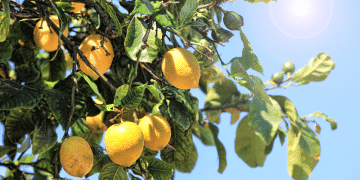Guide: 10 Essential Steps to Restore Your Garden After Heavy Rain Damage
Understanding the Impact of Heavy Rain on Your Garden 🌧️🌿
Heavy rain can have a significant impact on your garden, affecting its health and soil structure.
Excessive rainfall can lead to waterlogged soils, nutrient leaching, and physical damage to plants.
Understanding these effects is crucial for effective garden management and recovery after heavy rain events.

How Excessive Rainfall Affects Garden Health and Soil Structure 🌱💧
When rain falls in large quantities, it saturates the soil, leaving no room for air.
This waterlogged condition deprives plant roots of oxygen, leading to root rot and plant stress.
Excessive water can also compact the soil, reducing its ability to drain well and hindering the growth of your garden plants.
Additionally, nutrients can be washed away by heavy rain, resulting in a lack of essential elements needed for plant growth.
Common Signs of Water Damage in Gardens 🌧️
Heavy rain often leaves telltale signs of its impact:
-
Yellowing or wilting leaves as plants suffer from root rot.
-
Soil with poor drainage remaining waterlogged for an extended period.
-
Post-rain crusting or cracking soil surface.
-
Muddy surfaces and sediment deposits after water recedes.
-
Stunted growth or disease in water-sensitive plants.
Importance of Immediate Action After Heavy Rain Events ⚠️🌿
Taking immediate action after a heavy rain event is crucial to mitigate damage and revive your garden.
Quick response helps in preventing long-term issues such as nutrient deficiencies and plant diseases.
Start by inspecting your garden, identifying the extent of the damage, and addressing any immediate hazards.
This early intervention can significantly boost your garden’s resilience and return it to good health more effectively.
By addressing these initial impacts, you’ll be well on your way to restoring and improving your garden.
Next, prioritize safety as you begin the assessment and clean-up process.
Safety First: Initial Assessment and Precautions 🦺
Checking for Weather Warnings and Flood Dangers ⚠️🌧️
Before stepping out to address garden damage after heavy rainfall, prioritize safety first.
Nature can be unpredictable, and it’s crucial to ensure that the weather has stabilized.
Check for any ongoing weather warnings and assess flood dangers to prevent putting yourself at risk.
Essential Safety Gear 👒🧤
| Safety Gear | Description |
|---|---|
| 🧤 Gardening Gloves | Protect your hands from cuts, scratches, and soil-borne diseases like tetanus. |
| 🦟 Mosquito Repellent | Wet weather events attract mosquitoes. Prevent bites and potential diseases by using repellent. |
Identifying and Addressing Immediate Hazards 🚨🌳
Before diving into garden work, identify and address immediate hazards in your garden:
-
Fallen Trees and Branches: Check for broken limbs or fallen trees that could cause additional damage or injury. Remove them safely or seek professional help if needed.
-
Water Stagnation: Look for areas with standing water where mosquitoes can breed. Drain or treat these spots promptly.
-
Debris: Clear away any debris such as branches, leaves, or garden tools that could obstruct walkways or damage plants further.
By ensuring that your garden is safe and free from immediate threats, you can proceed with the restoration process with greater peace of mind.
Next, we will focus on managing waterlogged soil and easing your garden’s path to recovery. 🌍🌱
Addressing Waterlogged Soil Issues 💦🌿
Gardening enthusiasts understand that waterlogged soil is a formidable adversary.
But fret not—with patience and the right techniques, your soil can recover.
Let’s dive into the essentials.
Natural Drying Process 🌞
First and foremost, allow nature to run its course. After heavy rainfall, granting your garden time to dry naturally is crucial.
Sandy soils will absorb and release moisture faster than clay, speeding up the recovery process. However, patience is key for any soil type.
Enhancing Soil Structure 🌾
Improving the soil structure is a game-changer.
Incorporating coarse organic materials, such as compost or pine bark, can facilitate air movement within the soil, accelerating the drying process and restoring health.
This method reinvigorates the soil, allowing roots to breathe and promoting plant vigor.
Navigating Clay-Based Soils 🌱
Clay soils demand special care. Avoid disturbing them when wet as they compact easily, which can become a laborious problem to fix.
Instead, let them dry thoroughly before making amendments.
Adding a layer of compost over these areas can enhance structure gently, reducing future compaction risks.
Managing Mud and Sediment 🏞️💧
Guidelines for Handling Different Mud Thickness Levels 🌧️
After heavy rain, your garden might be left with varying levels of mud. It’s important to tackle this systematically.
For mud layers under 50 millimeters thick, you can incorporate mulch and dig the mud back into the soil.
This helps soil structure and nutrient composition. If mud exceeds 50 millimeters, it’s best to remove it and dispose of it, as it can smother plants and inhibit growth.
Using Gypsum and Organic Matter to Break Down Mud 🌿🧂
One of the best ways to manage persistent mud is by using gypsum. Spread a thick layer of gypsum over the muddy area and work it into the soil. Gypsum helps break down the mud and turns it into workable soil.
Incorporating organic matter, like compost or well-rotted manure, further enhances soil structure and fertility.
These organic additions promote microorganisms’ activity, which aids in breaking down the mud and improving soil health.
Techniques for Preventing Mud from Hardening 🌱🌾
Preventing mud from hardening is essential to maintaining a healthy garden environment.
Once mud begins to dry, it can turn as hard as concrete, making it difficult for plant roots to penetrate. To prevent this:
-
Mulch Application: Apply a thick layer of mulch over the muddy areas to retain moisture and prevent the mud from hardening.
-
Regular Cultivation: Regularly cultivate the soil using a garden fork or tiller to keep it loose and aerated.
-
Cover Crops: Plant cover crops or ground covers that can protect the soil from the sun and help maintain a friable soil structure.
By adhering to these steps, you can efficiently manage mud and sediment in your garden, ensuring a healthy growing environment for your plants.
Reviving Damaged Plants and Trees 🌳🌧️
After a heavy deluge, reviving your garden’s plants and trees is essential.
Administering the right care can make the difference between life and death for your cherished flora.
Cleaning Mud Residue 🧹
Mud residue on leaves can suffocate plants. It’s crucial to clean this off as soon as possible:
-
Hose off muddy leaves: Use a gentle water spray to remove dirt. This helps leaves breathe and resume photosynthesis.
-
Scrape mud from trunks: Mud built up around tree trunks can lead to collar rot. Carefully scrape away the dirt to allow trunk aeration.
Proper Pruning Techniques ✂️🌿
Next, properly prune any damaged plant parts. Pruning stimulates growth and helps plants recover faster:
-
Identify damaged stems: Look for stems that are broken, cracked, or bent.
-
Use clean, sharp tools: Ensuring your tools are clean prevents disease spread.
-
Prune at an angle: Cut damaged stems at a 45-degree angle just above a node to promote new growth.
Applying Organic Wetting Agents 💧🌿
Soil can become water-repellent after being waterlogged. Applying an organic wetting agent helps the soil recover:
-
Making your own wetting agent: Mix a few drops of mild dish soap with water. Apply this mixture to the soil, allowing it to penetrate deep into the roots.
-
Commercial options: Organic wetting agents available in garden centers can also be effective. Adhere to the instructions closely for optimal results.
Restoring your garden after heavy rain involves patience and the right techniques. With mud cleared, plants pruned, and soils treated, your greenery can make a fantastic comeback. 🌸
Soil Testing and Restoration 🌱🧪
Conducting pH Tests and Addressing Imbalances 🔬
After heavy rains, it’s essential to assess your soil’s health with a pH test.
Using a pH meter or a testing kit from your local garden center, measure the acidity or alkalinity of the soil. Ideally, vegetable gardens thrive in a pH range of 6.0 to 7.0.
If your soil is too acidic (pH below 6), you can add a handful of lime per square meter to neutralize it.
For highly alkaline soils (pH above 7), incorporating sulfur or organic matter like compost can help restore balance.
Testing for Contaminants in Vegetable Gardens 🧪💧
Floodwaters can introduce contaminants, making it crucial to test your vegetable garden soil.
Look for signs of chemicals or biological residues that could harm your plants and health.
If contamination is detected, it’s best to avoid consuming affected produce and consult local agricultural extensions for guidelines on remediation.
Replenishing Nutrients with Appropriate Fertilizers 🌿💥
Heavy rain can leach essential nutrients from the soil, leaving it less fertile. To replenish lost nutrients, consider the following:
-
General Garden Areas 🌻: Apply blood and bone meal or poultry manure at a rate of about a handful per square meter. These organic options provide a balanced nutrient supply to kickstart soil recovery.
-
Specific Nutrient Needs 🥕: If your soil test indicates specific deficiencies (e.g., nitrogen, phosphorus, potassium), use targeted fertilizers to address these gaps. For example, a nitrogen deficiency can be remedied with fish emulsion or feather meal.
By conducting these tests and acting on the results, you can help your garden bounce back more robustly and be better prepared for future rain events.
Future-Proofing Your Garden 🌍💧
Creating Raised Beds and Improved Drainage Systems 🌿🛠️
To future-proof your garden against heavy rain, start by creating raised beds.
Raised beds allow for better drainage by elevating the soil above the surrounding ground, which helps prevent waterlogging and root rot.
Make sure the beds are at least 12 inches high and filled with a well-draining soil mix.
This setup helps plants recover faster after heavy rainfall by ensuring their roots remain healthy.
Another effective strategy is to improve the overall drainage system of your garden. Installing French drains or gravel trenches can redirect excess water away from your plants.
Also, consider adding drainage pipes to guide water to a designated runoff area.
Installing Permeable Surfaces and Swales 🪨🌱
Installing permeable surfaces like gravel pathways and porous pavers enable rainwater to seep into the soil, rather than running off.
These surfaces help mitigate water pooling and erosion issues by enabling the water to percolate through and nourish the soil beneath.
Swales, or shallow trenches filled with vegetation, can capture and slow down rainwater runoff.
By planting water-tolerant shrubs along the edges, you create a natural barrier that absorbs and utilizes excess water.
This not only prevents erosion but also replenishes groundwater levels.
Selecting Flood-Resistant Plants and Ground Covers 🌺🌿
Opt for planting varieties that thrive in high rainfall areas.
Trees and shrubs with fibrous root systems, such as clumping bamboo, ornamental gingers, and swamp lilies, are excellent choices.
These plants assist in stabilizing the soil and preventing erosion. Additionally, native sedges and rushes, like the Knobby club rush, are well-adapted to water-prone gardens.
Strategically placing water-tolerant species throughout your garden ensures that these plants can handle the influx of water, thus maintaining the overall health of your garden.
It’s also important to consult local nurseries for advice on the best plants suited to your specific area.
Closing Thoughts 🌳🌧️
As you enhance your garden’s resilience against future weather events, focusing on creating effective drainage and selecting suitable plant varieties will make a significant impact.
These proactive measures will ensure your garden thrives despite the challenges posed by heavy rain.
Recommended Plants for Wet Conditions 🌼💧
Choosing the right plants for a water-prone garden can greatly enhance its resilience and beauty.
Here are some excellent plant varieties and strategic placement tips to keep your garden thriving.
Best Plant Varieties for High-Rainfall Areas 🌧️🌱
High-rainfall gardens need plants that can withstand excess moisture without root rot or fungal diseases. Here are some top choices:
-
Clumping Bamboo 🌿: Perfect for adding height and privacy to your garden, clumping bamboo thrives in wet conditions.
-
Ornamental Gingers 🌸: With their vibrant blooms, these gingers can handle soggy soils effortlessly and bring a tropical feel to your garden.
-
Swamp Lilies 🌸: Known for their attractive white flowers, swamp lilies do well in wet soils and provide a lovely fragrance.
-
Native Sedges and Rushes 🌾: Plants like the Knobby club rush not only thrive in wet conditions but also help control erosion.
-
Rainforest Palms 🌴: These palms can adapt to the fluctuating moisture levels typical of high-rainfall regions.
-
Swamp Banksia 🌳: Being native to Australia, this plant is well-suited to wet conditions and supports local biodiversity.
-
Water Gums 🌳: These trees withstand heavy rains and add charm to the garden with their lovely yellow flowers.
Native Options for Water-Prone Gardens 🌱💧
Native plants are often the best choices for water-prone gardens as they adapt well to local conditions and support the ecosystem.
Consulting with a local native nursery can provide specific recommendations for your area.
Native options can include species of sedges, rushes, and banksia that are naturally suited to wet conditions.
Strategic Placement of Water-Tolerant Species 🌿🌧️
Careful placement of water-tolerant species can maximize their benefits and ensure a healthy garden landscape:
-
Low-Lying Areas 🌊: Plant species such as swamp lilies and native sedges in areas where water naturally pools.
-
Borders 🌻: Use clumping bamboo and ornamental gingers along borders to create a lush, water-absorbing barrier.
-
Near Drains and Downspouts 🌊: Position rainforest palms and water gums where drainage is an issue, as their roots will help manage excess moisture.
-
Erosion Control 🏞️: Implement native rushes on slopes or areas prone to erosion to stabilize the soil.
By selecting and strategically placing these water-resistant plants, you can turn a potential problem into an opportunity to enrich your garden’s aesthetic and ecological value.
Preventive Measures for Future Rain Events 🌧️🚧
Keeping a garden healthy and resilient against heavy rain starts with proactive measures.
Understanding how regular maintenance and strategic choices can prevent damage is essential for long-term success.
Regular Maintenance of Gutters and Drainage Systems 🧹💧
Preventing water damage starts at the top. Regular clearing of gutters and downspouts guarantees that rainwater is effectively redirected away from your house and garden.
Clogged gutters can cause overflow, potentially harming structures and saturating the garden beds.
-
Inspect and clean: Clean the gutters at least twice annually or more often if there are trees hanging overhead.
-
Check downspouts for blockages and ensure water is flowing freely.
-
Consider gutter protectors to avoid debris buildup.
Proper Tree Management and Pruning Schedules 🌳✂️
Trees are an integral part of the garden but can become hazardous during heavy rainfall if not well-maintained.
Proper pruning helps in reducing the risk of falling branches and enhances tree health.
-
Schedule regular pruning of overhanging branches, especially near power lines and structures.
-
Remove dead or brittle limbs, particularly before the rainy season.
-
Thin tree canopies to reduce wind resistance and allow better light and air penetration.
Creating Effective Water Barriers and Flood Controls 💧🚧
Strategically placed barriers can significantly reduce the impact of heavy rains. Implementing physical and landscape solutions helps in managing water flow and preventing erosion.
-
Swales and Contour Bunding: Simple trenches along the contour lines of slopes can act as water catchment barriers. They slow down and capture runoff, reducing erosion and allowing water to infiltrate the soil.
-
Temporary Solutions: During forecasted heavy rain events, hay bales and hessian sacks filled with soil can serve as quick, temporary barriers. Place them strategically across vulnerable areas.
-
Permeable Surfaces: Replace impermeable surfaces like concrete with gravel paths or permeable pavers. These allow rainwater to percolate and reduce surface runoff.
By incorporating these preventive measures, you can mitigate the adverse effects of heavy rains, maintaining the integrity and health of your garden.
Being proactive ensures your garden can thrive regardless of the weather challenges it faces.
Long-term Garden Resilience 🌿💪
Achieving long-term resilience in your garden requires thoughtful planning and consistent care.
By implementing sustainable drainage solutions, developing a garden maintenance schedule, and building soil health for optimal water management, you can protect your garden from future heavy rain events and ensure it thrives all year round.






